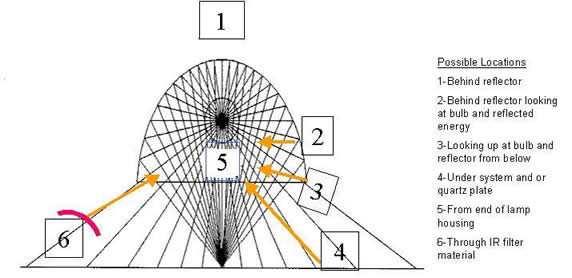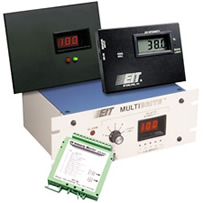Guide to UV Measurement
Absolute and Relative Instruments
There are several ways to classify measurement instruments and devices. The format on how their values are displayed (absolute or relative) is one way. Specific types of instruments are discussed later.
Absolute Instruments
Absolute reading instruments are calibrated against a standard. For UV curing applications, absolute instruments (radiometers) most often report Watts/cm² or Joules/cm² for the spectral bandwidth of that instrument. The bandwidth may vary from manufacturer to manufacturer. Profiling radiometers can provide the irradiance and radiant energy density figures while also profiling the irradiance as a function of time. This is useful when looking at multi-lamp systems, comparing current conditions with previous conditions and also for determining if a lamp system is running in or out of focus. Instruments known as spectroradiometers report the irradiance in W/cm² /nm, which is the irradiance for an extremely narrow spectral bandwidth-often a few nanometers or less. These are very useful instruments for determining the spectral distribution produced by a UV source.
Absolute reading instruments allow easier comparison between different UV systems, different locations and between suppliers-customers; for example, a coating formulator and user of the material. Caution needs to be exercised when making comparisons between different brands of absolute instruments. Different manufacturers look at different portions and bandwidths in the UV portion of the spectrum. There may also be differences based on the electronics of different types of instruments.
 |
 |
Conveyor based configurations
|
|
 |
 |
Web based configuration
|
|
 |
 |
Spot curing configurations
|
|
 |
 |
Profiling radiometers
|
|
Relative Instruments
Relative instruments or monitors provide feedback to the user on the relative intensity of UV reaching the sensor. A display, monitor or output signal is adjusted (often to 100%) when the equipment and cure conditions are ideal (clean reflector, new bulb). The display or output signal changes as the relative intensity of the UV changes. The subsequent readings can be expressed as a percentage of the new or established baseline. The readings obtained from relative instruments are specific only to the lamp being measured. In a multi-lamp system there should be a sensor for each lamp
Relative monitors are good for measuring UV on systems where the process window is small, where an absolute radiometer cannot be passed through or inserted into the system or where continuous feedback of the process is needed. While the output can tell you how much the lamp system has degraded over time it cannot indicate the amount of radiation reaching the product.
Relative Monitors |
Relative Sensors |
Location and Coordination
Relative instruments or absolute instruments inserted in the process are dependent on the location of the sensor.
A probe that is calibrated to an absolute standard measures and reports the UV arriving at its location in the system - the input aperture to the probe. Depending on the system, the access point and measurement location of the probe tip may be near or far from to the substrate cure surface. Often, a probe radiometer, even though it was calibrated to an absolute standard, is used in a relative manner.
The same is true for a sensor installed permanently in a UV System. Ideally the sensor will be installed where it can monitor the UV arriving at the cure surface. The ideal location would monitor the direct and reflected UV. If a quartz plate were located between the UV source(s) and the cure surface, the mounting location of the relative sensor would also monitor this plate. Space, equipment and mounting locations sometimes require that the sensor monitor only the direct UV instead of the UV arriving at the cure surface.

Unless the readings are coordinated with an absolute reading radiometer, it is hard to make direct comparisons between different systems and communicate with suppliers because ‘100%' on one system may not equate to ‘100%' on a second system.

